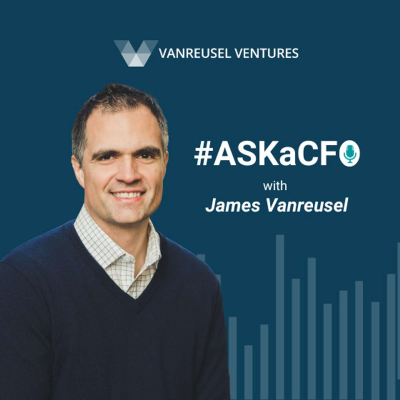
Ask a CFO- A weekly Q & A on corporate finance topics
Podcast by James Vanreusel
Ask a CFO is a weekly corporate finance Q & A with CEO of Vanreusel Ventures, James Vanreusel. James, has over 15 years of experience working at a CFO level for international non-profit and for-profit companies with a focus on impact in tech, healthcare. Each week James will answer a question sent to him, on topics surrounding: corporate finance, entrepreneurship milestones, FP& A, tech stacks, growing pains, investor relations, fundraising, M&A and more. Growing and scaling a business is a roller coaster ride, by answering these common questions CEO's will be able to get to their ideal results as fast as possible, get past each milestone and eventually....scale.
Aloita 7 vrk maksuton tilaus
Kokeilun jälkeen 7,99 € / kuukausi.Peru milloin tahansa.
Kaikki jaksot
41 jaksotIn this episode of "Ask a CFO," James delves into the concept of unit economics and how non-profit organizations can effectively calculate the cost per beneficiary. He explains that this can be done in several ways. James also explains why it is important to calculate the indirect cost rate. Finally, he discusses whether there is a minimum or maximum cost per beneficiary. The episode provides valuable insights into leveraging unit economics to improve the effectiveness and sustainability of non-profit programs. Key takeaways: * Cost Per Beneficiary: Simple calculation by dividing the total budget by the number of beneficiaries. * Program-Specific Costs: Unit cost calculation for each program, including direct expenses and salaries. * Indirect Cost Rate: Importance of building this in detail with audited financials. * Cost Guidelines: Discussion on minimum and maximum cost per beneficiary. Send your question to #AskaCFO [https://docs.google.com/forms/u/3/d/e/1FAIpQLSd0cMgOUTploC4WBZm2zKtovflfjj2CYRWOZBA3FRVD_mADCQ/viewform?usp=send_form] Sign up for the free starter membership below for access to free resources and financial tools which are created to support you at every step of your journey. Click HERE [https://products.vanreuselventures.com/starter-sign-up] Connect with us: LinkedIn [https://www.linkedin.com/in/jamesvanreusel/] Youtube [https://www.youtube.com/playlist?list=PL7-6z47BPMnY9eJn0gCha6gv1WtquitMm] Website [https://vanreuselventures.com/]
Episode 13: In this episode of "Ask a CFO," James explores how non-profit organizations can create a sustainable budget for the next years, especially when facing a current lack of funding but with plans for future growth. He discusses the importance of providing donors with a projection and then comparing it with the current year’s budget to identify any risks. Finally, he lists what is needed to create a sustainable budget for the future. Key takeaways: * 3-Year Projection: Detail anticipated growth, sales figures, and required funding. * Current vs. Projected Budget: Compare current budget with 3-year projection to identify risks. * Sustainable Budgeting: Careful planning, transparency, and good communication with stakeholders. Send your question to #AskaCFO [https://docs.google.com/forms/u/3/d/e/1FAIpQLSd0cMgOUTploC4WBZm2zKtovflfjj2CYRWOZBA3FRVD_mADCQ/viewform?usp=send_form] Sign up for the free starter membership below for access to free resources and financial tools which are created to support you at every step of your journey. Click HERE [https://products.vanreuselventures.com/starter-sign-up] Connect with us: LinkedIn [https://www.linkedin.com/in/jamesvanreusel/] Youtube [https://www.youtube.com/playlist?list=PL7-6z47BPMnY9eJn0gCha6gv1WtquitMm] Website [https://vanreuselventures.com/]
In this episode of "Ask a CFO," James discusses how non-profit organizations can manage funds with donor restrictions, ensuring accurate reporting and transparency. He highlights the use of accounting software and the importance of time tracking. James also shares some useful ways to track fund releases, the significance of managing the balance sheet to avoid negative restricted assets, and the need to include and accurately track restricted funding in the budget over time. Key takeaways: * Transparency and Accountability: Essential for maintaining donor trust. * Detailed Expense Tracking: Use accounting software and time tracking. * Fund Release Tracking: Implement a TRNA schedule. * Financial Management: Avoid negative restricted assets on the balance sheet. * Budget Integration: Track restricted funds accurately over time. Send your question to #AskaCFO [https://docs.google.com/forms/u/3/d/e/1FAIpQLSd0cMgOUTploC4WBZm2zKtovflfjj2CYRWOZBA3FRVD_mADCQ/viewform?usp=send_form] Sign up for the free starter membership below for access to free resources and financial tools which are created to support you at every step of your journey. Click HERE [https://products.vanreuselventures.com/starter-sign-up] Connect with us: LinkedIn [https://www.linkedin.com/in/jamesvanreusel/] Youtube [https://www.youtube.com/playlist?list=PL7-6z47BPMnY9eJn0gCha6gv1WtquitMm] Website [https://vanreuselventures.com/]
In this episode of "Ask a CFO," we talk about the crucial question of how to strategize to get all your company's debt paid. It might not sound like the wildest ride in the financial theme park, but managing debt is crucial for success, and our host has some insights to share. Here are three key takeaways from this episode: Key takeaways: * Debt Management is Critical for Fundraising: excessive debt can hinder a company's ability to raise funds and grow. While debt itself is not inherently bad, it's essential to be cautious about the types of debt you take on. * Prioritize Debt with Personal Guarantees: paying down debt with personal guarantees should be a top priority. Debt with personal guarantees can significantly increase stress levels if the company encounters difficulties. * Consider Debt Rollover and Forward-Looking Projections: For certain types of debt, such as venture debt, renegotiation and rollover options can be explored. It's crucial to have forward-looking projections to understand when debt payments will come due and align fundraising milestones accordingly. Equity investors are more interested in supporting business growth than in paying down existing debt. Send your question to #AskaCFO [https://forms.gle/77q27UA74aKVsuic6] Sign up for the free starter membership below for access to free resources and financial tools which are created to support you at every step of your journey. Click HERE [https://products.vanreuselventures.com/starter-sign-up] Connect with us: LinkedIn [https://www.linkedin.com/in/jamesvanreusel/]Twitter [https://twitter.com/JamesVanreusel]Youtube [https://youtube.com/playlist?list=PL7-6z47BPMnY9eJn0gCha6gv1WtquitMm]Website [https://www.vanreuselventures.com]
Welcome back to another episode of "Ask a CFO," the discussion centers around the concept of continuous accounting close. The primary focus is on how companies can expedite the monthly, quarterly, or yearly financial close process, aiming to avoid waiting until the end of the month to reconcile and finalize their financial records. The episode emphasizes that continuous accounting involves consistently updating and reconciling financial data throughout the month, ensuring that the books are not outdated at any point during the accounting period. This proactive approach is particularly valuable for large companies with numerous transactions and various departments that need to coordinate the close process. It also highlights the importance of looking at specific elements like accounts payable, accounts receivable, and revenue recognition on an ongoing basis to reduce stress and improve the efficiency of the accounting team. Key takeaways: * Continuous Accounting Close Definition: it's about updating financial records and reconciling accounts throughout the month, rather than waiting until the end of the month. This approach ensures that financial data is up-to-date and accurate. * Benefits of Continuous Accounting: Continuous accounting helps reduce stress for the accounting team by avoiding last-minute rushes at month-end. It allows for better control of financial processes, such as accounts payable (AP) and accounts receivable (AR), and ensures timely revenue recognition. * Gradual Implementation: Implementing continuous accounting is a gradual process, starting with incremental improvements to different accounting processes. This approach, called "crawl, walk, run," ensures that each aspect of the close is continuously monitored and updated, leading to more efficient and accurate financial reporting. Send your question to #AskaCFO [https://forms.gle/77q27UA74aKVsuic6] Sign up for the free starter membership below for access to free resources and financial tools which are created to support you at every step of your journey. Click HERE [https://products.vanreuselventures.com/starter-sign-up] Connect with us: LinkedIn [https://www.linkedin.com/in/jamesvanreusel/]Twitter [https://twitter.com/JamesVanreusel]Youtube [https://youtube.com/playlist?list=PL7-6z47BPMnY9eJn0gCha6gv1WtquitMm]Website [https://www.vanreuselventures.com]
Aloita 7 vrk maksuton tilaus
Kokeilun jälkeen 7,99 € / kuukausi.Peru milloin tahansa.
Podimon podcastit
Mainoksista vapaa
Maksuttomat podcastit



















